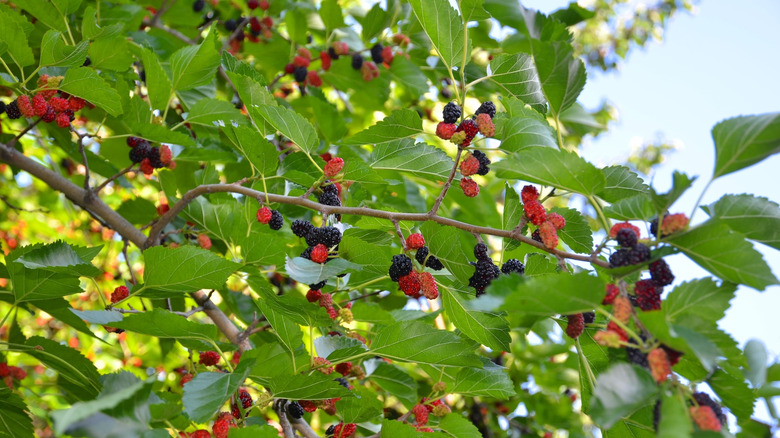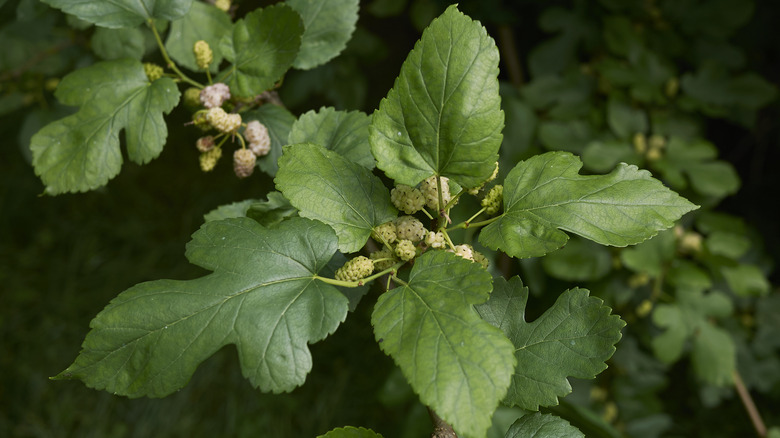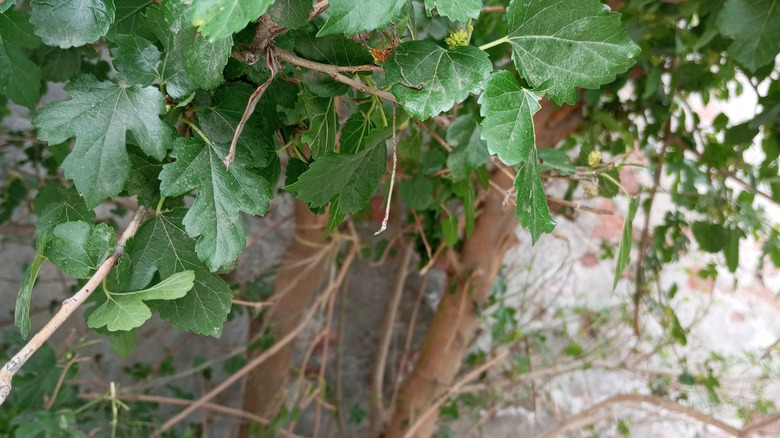Why Are Some Mulberry Trees Illegal To Grow?
Mulberries have a long history as landscape trees that are attractive to birds and wildlife due to their large leaf canopies and abundant berries. In the United States, there are three primary species of mulberry trees: red (Morus rubra), white (Morus alba), and black (Morus nigra). Of these varieties, only one is illegal to plant due to its invasive nature. The white mulberry tree cannot be legally planted in the entire states of Wisconsin and Maryland, according to Invasive.org. It also appears on many city and state invasive species lists and is considered a noxious weed in even more areas.
While the native red mulberry has been a favorite among humans and wildlife, white mulberries have begun to hybridize with them in the wild, resulting in species that are destroying ecosystems. This destruction of native habitats is what makes white mulberry illegal to plant in many areas. This type of mulberry spreads rapidly and aggressively, and once established, these weed trees grow as much as two feet in one year. Fortunately, black mulberries are much less problematic. They do not appear on any invasive species list. There are many cultivars of this species thanks to the exceptional flavor of its fruit.
Issues with white mulberry trees
The invasive qualities of a plant have to be pretty extreme in order for it to be listed as illegal to plant in entire states. This is certainly the case with white mulberry trees, and the reason you should rethink planting this bird-attracting tree in your yard. Although they are mulberries and produce some fruit, these berries are bland compared to their non-invasive relatives. And while they may not be appealing to human palates, birds love them. They consume the berries and deposit the seeds as they travel, further expanding the spread of this invasive tree.
Seed dispersal is a significant problem, but the white mulberry's biggest threat lies in its rapid growth and spread. These trees have fast-growing roots that can break through concrete and squeeze into the cracks of foundations. These invasive attributes explain why these trees can overtake urban and rural settings quickly and why some cities and states have responded by making them illegal to plant.
Identifying white mulberry trees and better alternatives
The leaves of white mulberry trees have toothed edges that may have up to five lobes each. The roots of sapling trees are often yellow-orange, making them easy to identify. More mature trees have a slight orange hue to the pale tan bark. To ensure young trees are completely removed, pull them up, roots and all. Mowing is not an effective method of control and can even stimulate root growth. Sometimes cutting down a mature white mulberry is the only solution to lessening its negative impact on the ecosystem.
If cutting down a tree that provides shade and food for wildlife feels like a significant loss, other options should be considered for planting in its place. Some native, non-invasive alternatives to white mulberry can be planted instead of this problematic tree. Of course, native red mulberry is a good option. Depending on your preferences and location, other replacements for white mulberry could include flowering trees like Eastern redbud or wild gum. Nut trees like hazelnut or hickory are great for wildlife, as are fruit trees such as cherry, pear, or serviceberry. Check with your local tree nursery, arborist, or cooperative extension to get advice on which trees are best in your area. There are a few things to consider before planting a fruit tree, such as its mature size, growing conditions, and how much care and maintenance it needs.


